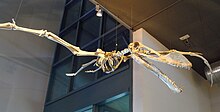Our website is made possible by displaying online advertisements to our visitors.
Please consider supporting us by disabling your ad blocker.
Ornithocheiromorpha
| Ornithocheiromorphs | |
|---|---|

| |
| Reconstructed skeleton of Tropeognathus in the National Museum of Brazil | |

| |
| Skeletal cast of Maaradactylus spielbergi in the Naturalis Biodiversity Center | |
| Scientific classification | |
| Domain: | Eukaryota |
| Kingdom: | Animalia |
| Phylum: | Chordata |
| Order: | †Pterosauria |
| Suborder: | †Pterodactyloidea |
| Clade: | †Pteranodontoidea |
| Clade: | †Ornithocheiromorpha Andres et al., 2014 |
| Subgroups | |
| |
Ornithocheiromorpha (from Ancient Greek, meaning "bird hand form") is a group of pterosaurs within the suborder Pterodactyloidea. Fossil remains of this group date back from the Early to Late Cretaceous periods (Valanginian to Turonian stages), around 140 to 92.5 million years ago. Ornithocheiromorphs have been discovered worldwide except Antarctica, though most genera have been recovered in Europe, Asia and South America.[2] They were the most diverse and successful pterosaurs during the Early Cretaceous, but throughout the Late Cretaceous they were replaced by pteranodontians and azhdarchoids. The Ornithocheiromorpha was defined in 2014 by Andres and colleagues, and they made Ornithocheiromorpha the most inclusive clade containing Ornithocheirus, but not Pteranodon.[3]
Ornithocheiromorphs are considered to be some of the largest animals to have ever flown. Members of this group are also regarded to have some of the largest pterosaur wingspans, such as the one estimated for the huge Tropeognathus, though still not as large as those estimated for the azhdarchids, which may have reached up to 12 meters (39 ft).[4] When ornithocheiromorphs first appeared, they were initially scavengers, consisting in a more terrestrial setting, but their success had made them the top predators of the skies, as well as the most common type of fish-eating pterosaur throughout the early Late Cretaceous. Some paleontologists also consider ornithocheiromorphs an earlier step of evolution to the pteranodontians, this is due to the similar flying techniques and flight locomotions, as well as their diet, which mainly consisted of fish, and therefore also hunted very similarly. Ornithocheiromorphs also flew like soaring birds, keeping their wings stretched and rarely flapping.
- ^ Jiang, Shun-Xing; Zhang, Xin-Jun; Cheng, Xin; Wang, Xiao-Lin (2020). "A new pteranodontoid pterosaur forelimb from the upper Yixian Formation, with a revision of Yixianopterus jingangshanensis". Vertebrata PalAsiatica. doi:10.19615/j.cnki.1000-3118.201124.
- ^ Barrett, P. M., Butler, R. J., Edwards, N. P., & Milner, A. R. (2008). Pterosaur distribution in time and space: an atlas. Zitteliana: 61-107.[1]
- ^ Andres, B.; Clark, J.; Xu, X. (2014). "The Earliest Pterodactyloid and the Origin of the Group". Current Biology. 24 (9): 1011–6. Bibcode:2014CBio...24.1011A. doi:10.1016/j.cub.2014.03.030. PMID 24768054.
- ^ Witton, M.P.; Martill, D.M.; Loveridge, R.F. (2010). "Clipping the Wings of Giant Pterosaurs: Comments on Wingspan Estimations and Diversity". Acta Geoscientica Sinica. 31: 79–81.
Previous Page Next Page


